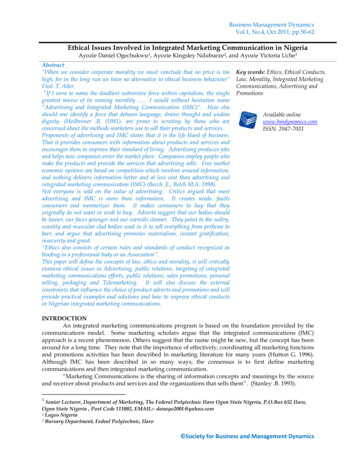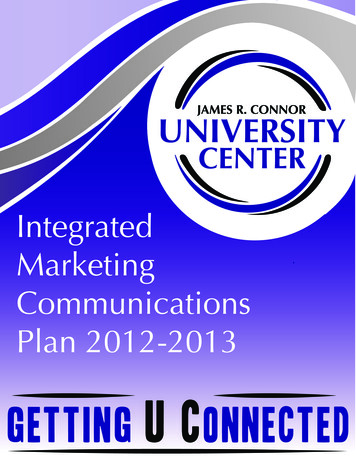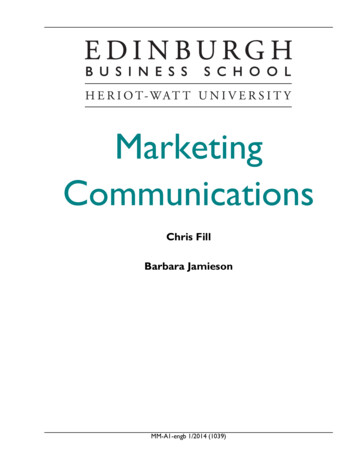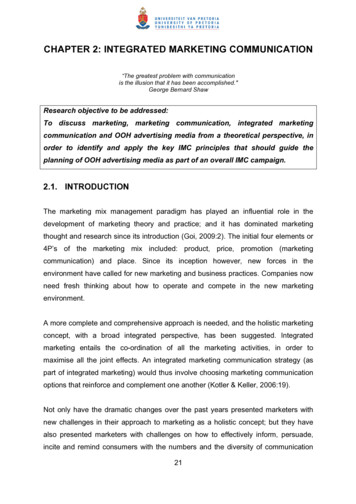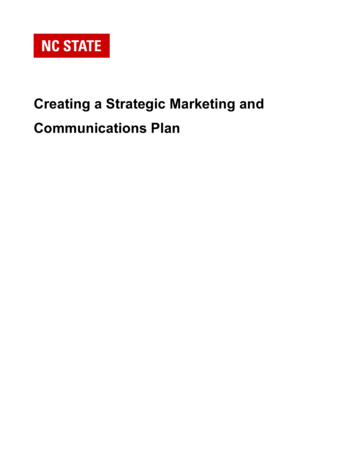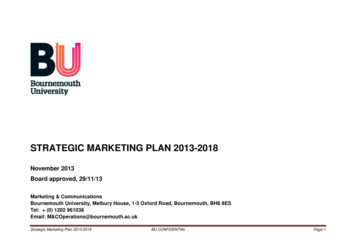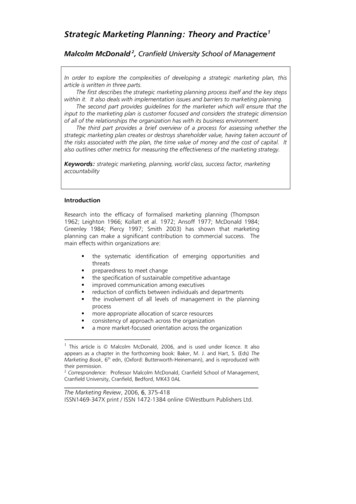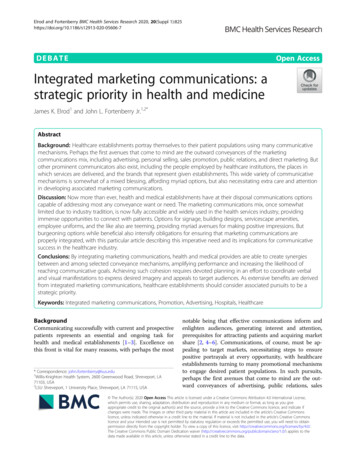
Transcription
Elrod and Fortenberry BMC Health Services Research 2020, 20(Suppl BATEOpen AccessIntegrated marketing communications: astrategic priority in health and medicineJames K. Elrod1 and John L. Fortenberry Jr.1,2*AbstractBackground: Healthcare establishments portray themselves to their patient populations using many communicativemechanisms. Perhaps the first avenues that come to mind are the outward conveyances of the marketingcommunications mix, including advertising, personal selling, sales promotion, public relations, and direct marketing. Butother prominent communicators also exist, including the people employed by healthcare institutions, the places inwhich services are delivered, and the brands that represent given establishments. This wide variety of communicativemechanisms is somewhat of a mixed blessing, affording myriad options, but also necessitating extra care and attentionin developing associated marketing communications.Discussion: Now more than ever, health and medical establishments have at their disposal communications optionscapable of addressing most any conveyance want or need. The marketing communications mix, once somewhatlimited due to industry tradition, is now fully accessible and widely used in the health services industry, providingimmense opportunities to connect with patients. Options for signage, building designs, servicescape amenities,employee uniforms, and the like also are teeming, providing myriad avenues for making positive impressions. Butburgeoning options while beneficial also intensify obligations for ensuring that marketing communications areproperly integrated, with this particular article describing this imperative need and its implications for communicativesuccess in the healthcare industry.Conclusions: By integrating marketing communications, health and medical providers are able to create synergiesbetween and among selected conveyance mechanisms, amplifying performance and increasing the likelihood ofreaching communicative goals. Achieving such cohesion requires devoted planning in an effort to coordinate verbaland visual manifestations to express desired imagery and appeals to target audiences. As extensive benefits are derivedfrom integrated marketing communications, healthcare establishments should consider associated pursuits to be astrategic priority.Keywords: Integrated marketing communications, Promotion, Advertising, Hospitals, HealthcareBackgroundCommunicating successfully with current and prospectivepatients represents an essential and ongoing task forhealth and medical establishments [1–3]. Excellence onthis front is vital for many reasons, with perhaps the most* Correspondence: john.fortenberry@lsus.edu1Willis-Knighton Health System, 2600 Greenwood Road, Shreveport, LA71103, USA2LSU Shreveport, 1 University Place, Shreveport, LA 71115, USAnotable being that effective communications inform andenlighten audiences, generating interest and attention,prerequisites for attracting patients and acquiring marketshare [2, 4–6]. Communications, of course, must be appealing to target markets, necessitating steps to ensurepositive portrayals at every opportunity, with healthcareestablishments turning to many promotional mechanismsto engage desired patient populations. In such pursuits,perhaps the first avenues that come to mind are the outward conveyances of advertising, public relations, sales The Author(s). 2020 Open Access This article is licensed under a Creative Commons Attribution 4.0 International License,which permits use, sharing, adaptation, distribution and reproduction in any medium or format, as long as you giveappropriate credit to the original author(s) and the source, provide a link to the Creative Commons licence, and indicate ifchanges were made. The images or other third party material in this article are included in the article's Creative Commonslicence, unless indicated otherwise in a credit line to the material. If material is not included in the article's Creative Commonslicence and your intended use is not permitted by statutory regulation or exceeds the permitted use, you will need to obtainpermission directly from the copyright holder. To view a copy of this licence, visit http://creativecommons.org/licenses/by/4.0/.The Creative Commons Public Domain Dedication waiver ) applies to thedata made available in this article, unless otherwise stated in a credit line to the data.
Elrod and Fortenberry BMC Health Services Research 2020, 20(Suppl 1):825promotion, and other components of the traditional marketing communications mix, with these pathways beingtraversed extensively by health and medical organizationsin bids to connect with audiences [2, 4, 7, 8].Indeed, the components of the marketing communications mix are tried and true methods for engaging patient populations, but they are not the only avenuesavailable for doing so. Other prominent communicatorsalso exist, including the people employed by healthcareinstitutions, the places in which services are delivered,and the brands that represent given establishments,affording extended means for informing and enlightening customer groups [2, 4, 7, 9–12]. This wide variety ofcommunicative mechanisms, however, is somewhat of amixed blessing. While the burgeoning array of optionsaffords tremendous utility, healthcare providers mustdirect extra care and attention when assembling associated conveyances to ensure cohesion between andamong promotional elements. Such cohesion yields integrated marketing communications which should be astrategic priority for health and medical establishments.This particular article shares a range of insights on integrated marketing communications, providing usefulguidance for healthcare organizations seeking to bolstertheir patient engagement efforts.DiscussionNow more than ever, health and medical establishmentshave at their disposal communications options capable ofaddressing most any conveyance want or need. Today,healthcare institutions routinely make use of the full marketing communications mix, calling upon its five components of advertising, personal selling, sales promotion,public relations, and direct marketing as desired to reachtheir target audiences [2, 4, 13]. This starkly contrasts withprevailing healthcare industry mindsets of the not-sodistant past (ca. 1980s and earlier) which frowned onusing the full power of the marketing communicationsmix. Notably, advertising was viewed to be beneath thedignity of medical providers and potentially detrimental toestablished patient referral patterns. But associated resistance ended in the 1980s, aided notably by governmentalscrutiny of the American Medical Association’s ban on itsmembers’ use of advertising, paving the way for advertising to flourish, making the marketing communicationsmix fully accessible and acceptable for use in the healthservices industry [1, 5, 7, 9].Beyond the components of the marketing communications mix, foundational elements—people, places, andthings that communicate on behalf of healthcare institutions—also present more opportunities than ever to makepositive, enduring impressions. Cutting edge training programs, stylish uniforms, and the like have the potential todramatically elevate the actions and appearances ofPage 2 of 5healthcare personnel; modern exterior and interior signage options, especially digital variants, are capable of capturing attention like never before; and contemporaryservicescape designs and associated amenities have thepower to greatly impress and inspire target audiences.These and similar elements convey volumes of information to others, arguably projecting details as robustly asanything within the traditional marketing communications mix, crucially impacting the perspectives of currentand prospective patients and presenting immense opportunities to influence associated patronage decisions [2, 4,7, 9–12].But burgeoning communicative options, while beneficial, also intensify obligations for ensuring that marketingcommunications deployed by given healthcare institutionsare properly integrated to present a cohesive picture totarget audiences. Integrated marketing communications(IMC) happens to be a formal term in the discipline ofmarketing. It is defined as “the coordination of all of themarketing communications efforts of an organization forthe purpose of ensuring the consistent presentation ofpromotional messages to target audiences” [2], p. 286.Essentially, achieving integrated marketing communications yields a highly-desired communicative state whereall conveyances telegraphed by an establishment over agiven period of time are linked together. This typically isrealized through the use of a defined collection of verbaland visual manifestations (e.g., logos, slogans, colorschemes, themes), leading audiences to view each communication to be part of a comprehensive body of work presenting the establishment clearly and cohesively.Integration effectively creates synergies between andamong all of the promotional elements deployed by anorganization, amplifying the impact potential of communicative efforts [2, 4, 14–16].In the absence of such integration, communicative elements lack effective linkages. Imagine, for example, ascenario where a healthcare establishment, on adoptinga new slogan, updates its advertising to feature the newexpression, but neglects to revise its other promotionalmaterials, accordingly. Similarly, consider a situationwhere corporate colors have been updated, but somemarketing communications continue to make use of theformer color array. Given different creative treatments,communicative synergies cannot be leveraged, diminishing impact that otherwise would be possible via propercommunicative integration. Indeed, the necessity for integrating marketing communications is so pronouncedthat entire textbooks have been written on the topic(e.g., [17–21]), demonstrating its associated value andimportance.Achieving a marketing communications presence thatwould be considered to be integrated requires extensiveattention to detail. As various forms of promotion are
Elrod and Fortenberry BMC Health Services Research 2020, 20(Suppl 1):825developed, efforts must be directed toward ensuring thatthey work in harmony together, creating a cohesive, interrelated body of work [2, 4]. As content which portrayshealthcare establishments (e.g., signage, advertisements,sales promotions, websites, stationery, direct mail) usually is produced over time, the need for vigilance is quiteobvious, as without such, incongruence can appear inthe verbal and visual artifacts representing institutions,undermining efforts to achieve and maintain integrationbetween and among components. Such incongruencecan range from subtle (e.g., an updated font for use onbusiness cards and letterhead is introduced, butstationery featuring the old font continues to be circulated) to very obvious (e.g., a logo is revised, but signagecontinues to display the former identity), with such inconsistencies, regardless of magnitude, underminingcommunicative power and potential [4].To foster presentation of a consistent image across allmarketing communications, health and medical establishments can benefit by developing a creative style guide, acomprehensive marketing communications documentwhich presents depictions of approved verbal and visualelements representing given institutions and supplies detailed guidelines for their use. The exact composition ofsuch guides is dependent on the wants and needs of givenhealthcare establishments, but typical areas that are addressed include (1) logos, noting their proper display, use,and associated restrictions, (2) creative treatments, outlining approved typography, color schemes, and associatedstylistic elements, (3) messaging characteristics, notingPage 3 of 5approved slogans, storylines, and related content, (4) audience profiles, indicating served markets, associated targets,and demographic attributes, (5) communication avenues,identifying components of the marketing communicationsmix and any supplementary communications pathwaysthat are to be pursued, and (6) authorization processes,outlining protocols for presenting assembled communications to institutional leaders for review and approval, permitting dissemination.The activity of developing these guides, in and of itself, ishelpful in that it forces institutional leaders to think deeplyon the verbal and visual manifestations which represent theirgiven organizations, providing an opportunity to examineand potentially improve methods and manners of presentingtheir establishments to target audiences. This also aids inachieving communicative cohesion, as components are developed in an orderly fashion, something which avoids patchwork assembly methods which inadvertently can fosterincongruity [2, 4, 10, 22]. The all-important authorizationprocess is also addressed, further ensuring compliance withdesignated standards. By adhering to defined creative protocols, a clear identity emerges, essentially yielding consistentcreative signatures which amplify all marketing communications forwarded on behalf of healthcare institutions.In the 1970s, a particularly formative time period forthe institution, Willis-Knighton Health System laid thegroundwork for enduring integrated marketing communications by focusing on creative treatments and applications, with one of the most essential being thedevelopment of an appealing logo. Today, this logo isFig. 1 Several recent billboard advertisements promoting Willis-Knighton Health System
Elrod and Fortenberry BMC Health Services Research 2020, 20(Suppl 1):825one of the most widely recognized in the marketplaceand it anchors virtually every communication forwardedby the institution [9, 10]. Coupled with consistent colorschemes, slogans, and manners and methods of presentation, Willis-Knighton Health System’s particular creative treatment, regardless of the service line to which itis applied, builds communicative bridges between andamong each and every conveyance, naturally supplyingthe critical linkages that afford integrated marketingcommunications, as the sample billboard and newspaperadvertisements, provided in Figs. 1 and 2, and theFig. 2 A recent newspaper advertisement promoting Willis-KnightonHealth SystemPage 4 of 5sample television commercials, available at https://www.wkhs.com/video/commercials, illustrate.Applications of Willis-Knighton Health System’s creative style are not limited to conveyances of the traditional marketing communications mix; they influencedecisions pertaining to anything which communicateson behalf of the institution, guiding signage decisions,employee uniform designs, and so on, yielding a universal creative portrayal of the institution to its audiences.Such results stem from the devoted use of a creativestyle guide which, once assembled and approved, directsthe development and dissemination of content, providing reasonable assurances that presentations and portrayals of given institutions will be consistent.A healthcare establishment’s achievement of integratedmarketing communications is best ascertained by viewing the totality of communicative elements deployed bythe given institution. Interior and exterior signage,stationery, employee uniforms, promotional brochures,advertisements, direct mail pieces, website designs andassociated promotional content, and more should be examined comprehensively. If each element when viewedindividually appears to be part of the larger body ofwork, then integration pursuits can be deemed to havebeen successful. If not, corrective actions need to betaken to bring noncompliant promotional elements intocompliance with the communicative aims expressed inthe associated creative style guide, affording harmonybetween and among all conveyances.While the concept of integrated marketing communications might seem so obvious as to not warrant discussion,environmental complexities, propensities to lose sight ofthe bigger picture, routine distractions, and the like havethe potential to undermine and erode efforts to ensure cohesion between and among communicative components.As noted earlier, if proper attention is not directed towardthe assembly and management of elements promotinghealthcare establishments, incongruence eventually willemerge, diminishing the communicative power and potential of given expressions. The introduction and use of creative style guides, coupled with ongoing discussionsregarding the importance of integrated marketing communications, will help healthcare establishments stay oncourse for achieving harmony across all communications,reaping associated benefits.ConclusionsBy integrating marketing communications, health andmedical providers are able to portray themselves clearlyand consistently to their audiences, something that is absolutely essential for the best communicative outcomes.Further, synergies will emerge between and among the deployed conveyance mechanisms, amplifying performanceand increasing the likelihood of reaching communicative
Elrod and Fortenberry BMC Health Services Research 2020, 20(Suppl 1):825goals, ultimately improving the return on investment generated by the associated marketing communications.Achieving such cohesion requires devoted planning in aneffort to coordinate verbal and visual manifestations to express desired imagery and appeals to target audiences,with guiding protocols and reminders to maintain integration being essential as a defense against oversights and distractions which could lead to communicationsincongruence. As extensive benefits are derived from integrated marketing communications, healthcare establishments should consider associated pursuits to be astrategic priority.AcknowledgmentsA special note of thanks is extended to Marilyn Joiner, Darrell Rebouche, andthe greater Willis-Knighton Health System family for their helpful assistancethroughout the development and publication of this article.About this supplementThis article has been published as part of BMC Health Services ResearchVolume 20 Supplement 1, 2020: Marketing communications in health andmedicine: perspectives from Willis-Knighton Health System. The full contentsof the supplement are available online at /supplements/volume-20-supplement-1.Authors’ contributionsThe authors jointly developed the submitted manuscript, with eachperforming critical roles from early conceptualization through to theproduction of the full manuscript. The manuscript resulted from acollaborative effort. Both authors read and approved the final manuscript.Authors’ informationJKE is President and Chief Executive Officer of Shreveport, Louisiana-basedWillis-Knighton Health System, the region’s largest provider of healthcare services. With over 55 years of service at the helm of the institution, JKE isAmerica’s longest-tenured hospital administrator. A fellow in the AmericanCollege of Healthcare Executives and honoree as a Louisiana Legend byFriends of Louisiana Public Broadcasting, he holds a bachelor’s degree inbusiness administration from Baylor University, a master’s degree in hospitaladministration from Washington University School of Medicine, and an honorary doctorate of science and humane letters from Northwestern State University of Louisiana. He is the author of Breadcrumbs to Cheesecake, a bookwhich chronicles the history of Willis-Knighton Health System.JLF Jr. is Chair of the James K. Elrod Department of Health Administration,James K. Elrod Professor of Health Administration, and Professor of Marketingin the College of Business at LSU Shreveport where he teaches a variety ofcourses in both health administration and marketing. He holds a BBA inmarketing from the University of Mississippi; an MBA from MississippiCollege; a PhD in public administration and public policy, withconcentrations in health administration, human resource management, andorganization theory, from Auburn University; and a PhD in businessadministration, with a major in marketing, from the University of Manchesterin the United Kingdom. He is the author of six books, including Health CareMarketing: Tools and Techniques, 3rd Edition, published by Jones and BartlettLearning. JLF Jr. also serves as Vice President of Marketing Strategy andPlanning at Willis-Knighton Health System.FundingArticle processing charges were funded by Willis-Knighton Health System.Availability of data and materialsNot applicable.Ethics approval and consent to participateNot applicable.Page 5 of 5Consent for publicationFigures 1 and 2 are published with permission of Willis-Knighton Health System. All required approvals for publication were obtained.Competing interestsJKE and JLF Jr. are both employed with Willis-Knighton Health System.Published: 15 September 2020References1. Berkowitz E. Essentials of health care marketing. 4th ed. Burlington: Jonesand Bartlett; 2017.2. Fortenberry JL Jr. Health care marketing: tools and techniques. 3rd ed.Sudbury: Jones and Bartlett; 2010.3. Elrod JK, Fortenberry JL Jr. Healthcare establishments as owner-operators ofdigital billboards: making the most of excellent roadside visibility and hightraffic counts to better connect with patients. BMC Health Serv Res. 2018;18(Suppl 3):928.4. Fortenberry JL Jr. Cases in health care marketing. Sudbury: Jones andBartlett; 2011.5. Thomas RK. Marketing health services. 3rd ed. Chicago: HealthAdministration Press; 2014.6. Kotler P, Shalowitz J, Stevens RJ. Strategic marketing for health careorganizations: building a customer-driven health system. San Francisco:Jossey-Bass; 2008.7. Elrod JK, Fortenberry JL Jr. Formulating productive marketingcommunications strategy: a major health system’s experience. BMC HealthServ Res. 2018;18(Suppl 3):926.8. Elrod JK, Fortenberry JL Jr. Catalyzing marketing innovation and competitiveadvantage in the healthcare industry: the value of thinking like an outsider.BMC Health Serv Res. 2018;18(Suppl 3):922.9. Elrod JK. Breadcrumbs to cheesecake. Shreveport: R&R Publishers; 2013.10. Elrod JK, Fortenberry JL Jr. Driving brand equity in health servicesorganizations: the need for an expanded view of branding. BMC HealthServ Res. 2018;18(Suppl 3):924.11. Fortenberry JL Jr, McGoldrick PJ. Internal marketing: a pathway forhealthcare facilities to improve the patient experience. Int J Healthc Manag.2016;9(1):28–33.12. Elrod JK, Fortenberry JL Jr. Am I seeing things through the eyes of patients?An exercise in bolstering patient attentiveness and empathy. BMC HealthServ Res. 2018;18(Suppl 3):929.13. Fortenberry JL Jr. Nonprofit marketing. Burlington: Jones and Bartlett; 2013.14. Laurie S, Mortimer K. How to achieve true integration: the impact ofintegrated marketing communication on the client/agency relationship. JMark Manag. 2019;35(3/4):231–52.15. Keller KL. Unlocking the power of integrated marketing communications:how integrated is your IMC program? J Advert. 2016;45(3):286–301.16. Luxton S, Reid M, Mavondo F. Integrated marketing communicationcapability and brand performance. J Advert. 2015;44(1):37–46.17. Percy L. Strategic integrated marketing communications. 3rd ed. New York:Routledge; 2018.18. Juska JM. Integrated marketing communication: advertising and promotionin a digital world. New York: Routledge; 2018.19. Andrews JC, Shimp TA. Advertising, promotion, and other aspects ofintegrated marketing communications. 10th ed. Boston: Cengage; 2018.20. Clow KE, Baack D. Integrated advertising, promotion, and marketingcommunications. 8th ed. New York: Pearson; 2018.21. Moriarty S, Mitchell N, Wood C, Wells WD. Advertising and IMC: principlesand practice. 11th ed. New York: Pearson; 2019.22. Calder BJ, Reagan SJ. Brand design. In: Iacobucci D, editor. Kellogg onmarketing. New York: Wiley; 2001.Publisher’s NoteSpringer Nature remains neutral with regard to jurisdictional claims inpublished maps and institutional affiliations.
from integrated marketing communications, healthcare establishments should consider associated pursuits to be a strategic priority. Keywords: Integrated marketing communications, Promotion, Advertising, Hospitals, Healthcare Background Communicating successfully with current and prospect
